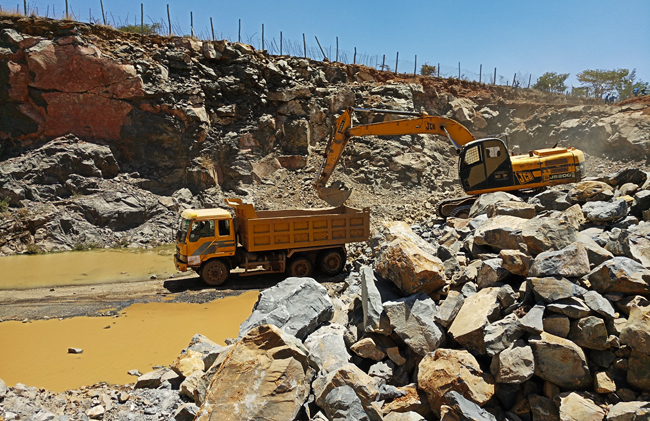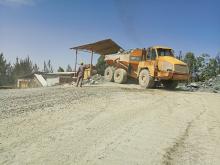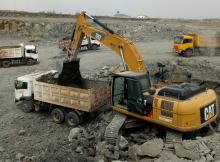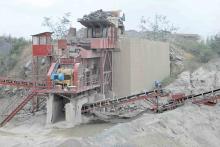
The Rift Valley Quarry in western Kenya changed ownership in January this year. New operator RVQ faces challenges including competition from larger neighbouring sites, but quarry manager Kurji Kara says there is major potential to ramp up aggregates volumes. Article by Shem Oirere.
The Rift Valley Quarry in Kenya can be classified as a small operator with a daily output that is currently around 200-250tonnes. However, the quarry’s manager Kurji Kara believes there is potential to increase aggregates volumes, particularly now that authorities are investing billions of Kenyan shillings in the construction industry.
A report by the Spanish embassy in Nairobi says that the Kenyan construction industry grew by 8.7% in 2017, and that this expansion is likely to be sustained for the next eight years.The Rift Valley Quarry, popularly referred to as RVQ and located in Uasin Gishu county, is something of a start-up in Kenya’s crowded small and medium quarry space. Previous operator Wallucat exited the site in January 2018, partly due to the pressure of competition from bigger nearby production sites. It is now operated by the RVQ company. The company was formed in late 2017 by a group of businessmen in the nearby town of Eldoret and launched its first operations in January 2018.
“The advantage quarry operators in any county in Kenya have is that most construction material is not easy to transport and, therefore, these devolved regions provide construction opportunities for local quarry companies such as RVQ that focus on the Uasin Gishu county construction market,” says Kara.
He adds that the quarry faces some tricky operational process issues - particularly on the effective control of dust, noise during blasting and the possible danger of flying rocks to residents near the quarry. Two schools have been constructed next to the quarry, and residential homes expanded to just a few metres from the mining site.
“There is a likelihood the rock underneath the mining site extends all the way to the neighbouring school and even homes, and we hope to negotiate with the community on the possibility of re-locating the institution to enable RVQ to exhaust the rock resource at this site,” says Kara, who has worked in Kenya’s construction materials sector for over a decade.
At the RVQ, the quarry process starts with a three-dimensional survey of what Kara calls ‘virgin surface’, a reference to potential rock-bearing spots that have not been touched, after which the top soil is removed and then the drilling phase started.
“However, since we started, we have concentrated on spots which had been cleared, top soil removed to expose the rock underneath and even the first layer of rocks mined but more layers left by the former operator which we are now mining,” Kara says.
He adds that quarry staff must plan the drilling meticulously to ensure each blast yields as much quality rock as possible.
“At times it requires great expertise for our team to determine precise spots to drill the shot holes for efficient and high-yielding blasting process,” says Kara. “Our daily concern and challenge is how to carry out the rock blasting with minimal noise and dust considering there are two schools and some homes near the quarry.”
The company frequently seeks professional support in achieving this tricky balancing act. Kara says: “We engage experts from the national environmental management authority (Nema) nearly all the time, and we also hire private ones to help us carry out blasting effectively.” Nema regulates all environmental matters in Kenya.
The RVQ quarry uses ammonium nitrate as a key ingredient in the blasting process. “We prefer to use this form of nitrogen fertilizer because it is readily available and easy to use when blasting rocks with a little mix of diesel, although it can do well with any other petroleum-based fuel,” said Kara. Blasting is conducted once or twice a week depending on the level of customer orders and the general demand for the construction material.
A
Because of the current size of the quarry, RVQ has two of each of these vehicles. It uses the two Doosan DX225 LC-3 excavators for land clearing and loading. The excavator is known for producing low noise levels, has enhanced visibility and more digging power according to South Korean manufacturer Doosan Group.
The quarry also uses a pair of FAW dump trucks with load capacity of 20-30tonnes which run on diesel with an engine capacity displacement of 9.726litres.
RVQ also owns two 15tonne TATA dump trucks with loading capacity of 11-20tonnes and engine capacity of 8litres, according to brand maker Daewoo Group.
Kara says that since RVQ is new, although operating an old quarry, it purchased equipment such as the crusher and screen second-hand rather than from major brands to minimise on starting capital costs.
RVQ produces mostly 88.9mm, 12.7mm and 6.35mm aggregates which it sells on a per tonne basis. The loaded trucks pass through a weighbridge at the exit of the quarry for confirmation of the tonnage before they are permitted to leave with the sand, gravel or crushed stone.
“In Uasin Gishu County, which is our focus market, consumers are largely builders and contractors of roads, highways, commercial and residential buildings and institutions such as churches and schools,” says Kara.
Commercial and residential buildings constructors who purchase aggregates from RVQ prefer the 12.7mm-sized aggregates, while road and highway builders prefer the 6.35mm-sized material.
“Some customers also buy crushed stone, especially 20mm size, for use in laying strong foundations for buildings and roads across Uasin Gishu County,” says Kara, adding that 10mm material is supplied to customers keen on achieving quality concrete for construction.
He adds that future growth of quarries in counties with fast-growing populations will depend on how the issue of encroachment of land near quarry areas is dealt with, as people seek more space for both agricultural production and other activities.
“One emerging trend, however, is that the market especially in Uasin Gishu is responsive to quality construction material driven mainly by a more demanding consumer segment and increasing competition in the industry,” says Kara. “This is especially the case among contractors that are keen on delivering quality construction works for public projects.”
“The future of RVQ on this site will depend on whether we successfully negotiate for re-location of the nearby institutions and avert expansion of residential homes towards the quarry.”










